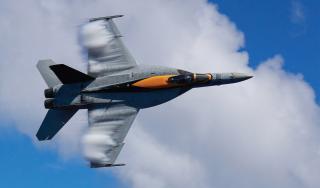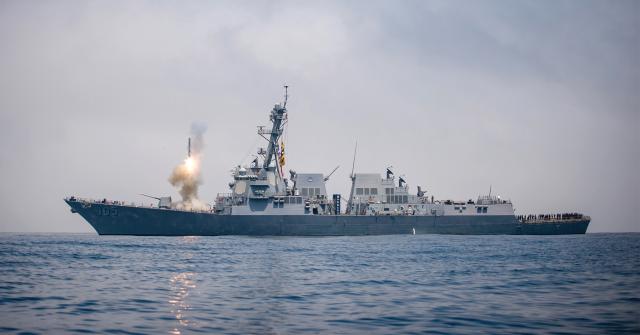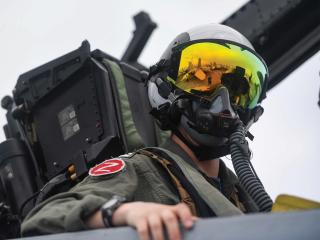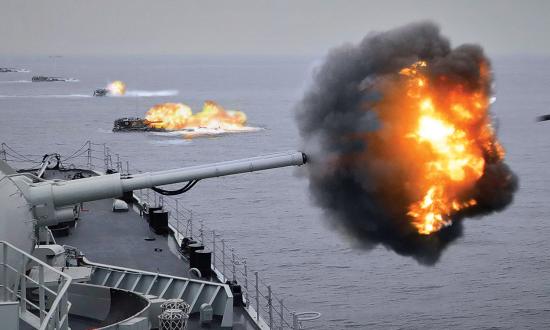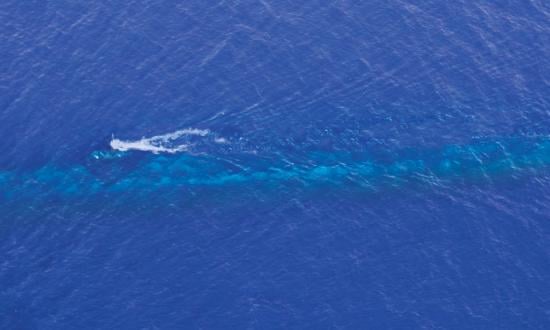One month into a full-scale Chinese invasion of Taiwan, the U.S. Navy’s strike warfare component will face harsh truths about the phrase “full-scale.” The Navy’s global power projection and supply problem will be centered on how to keep Taiwan in the fight despite the serious challenges both countries face. It is a problem U.S. strike warfare will struggle to address.
For the Navy, strike warfare assets primarily center on tactical naval aviation (TacAir—the Navy’s strike-fighter fleet) and ship- and submarine-launched Tomahawk land-attack cruise missiles (TLAMs).1 These assets provide a combination of flexibility and striking power, but their effects will be decisive only if the Navy can mitigate several “risks to inventory”—lack of sufficient aircraft, armaments, and aviators to remain in the fight.
The Operational Picture
The U.S. Navy will be at a disadvantage in this scenario: It must move forces toward and around Taiwan under the threat of Chinese observation and the “long guns” of People’s Liberation Army (PLA) missile forces.
Lord Admiral Horatio Nelson said, “A ship is a fool to fight a fort,” and China’s missiles turn its whole coastline into a fort, under whose guns lies Taiwan.2 With the PLA Navy (PLAN) prowling offshore, the U.S. Navy faces a layered defense that suits China’s long campaign of amphibious invasion and occupation. If landing forces and resupply can move across the Taiwan Strait unthreatened, the tide of the war will inexorably flow China’s way.
The United States must fight its way to the shores of Taiwan and bring with it the means to halt the Chinese advance. With bases in Japan and the western Pacific neutralized, U.S. naval forces may have to go it alone in the near term.
How can TacAir and TLAMs contribute to this campaign?
China’s formidable mix of cruise and ballistic missiles gives it a flexible means of power projection. However, PLA missiles are not infallible; their accuracy and reliability could be overhyped, and they rely on a robust PLA intelligence and reconnaissance complex.
The fixed objective—Taiwan—limits both Chinese defensive objectives and how the U.S. Navy can approach the problem without needlessly exposing itself to shore batteries.
If TacAir had long-range strike aircraft paired with low-observable organic tanker aircraft, hypersonic or high-supersonic land-attack missiles, organic long-duration surveillance platforms, and the inventory to sustain the initiative, the situation might not be so grim.
Without those resources, however, maintaining strike warfare operational tempo will be contingent on other missions, particularly antiair and antisurface warfare. If these missions can create enough of a sanctuary for TLAM and TacAir strikes, the strike warfare commander could pursue a mix of objectives: supporting the defense of Taiwan, eliminating PLA air defenses, and suppressing the long-range weapons that threaten the approaches to Taiwan.
Attacks against PLA landing sites on Taiwan would provide the most immediate relief for the island, but crippling ports of embarkation for PLA troops will slow the pace of the invasion. Given the long-distance amphibious objective (across the Taiwan Strait), striking amphibious embarkation points would severely complicate the PLA’s reinforcement and resupply problems.
Simultaneously, U.S. strike warfare must address the PLA missile batteries that will force U.S. ships to keep their distance from Taiwan. Closing the missile umbrella completely will require a long-duration campaign of intense strikes that may not be sustainable, so the strike warfare commander must be content with poking enough holes in the coverage to enable other strike missions.
Strike fires will need to be paired with electronic and cyber warfare methods of degrading PLA targeting to buy time for TLAMs and TacAir assets to get under the missile umbrellas, strike, and withdraw.
These operations will require tremendous courage. As with the boxer looking to score a few hits on a heavyweight foe, strike missions will leave U.S. forces open to counterattack, so mobility and a bit of derring-do will be key to seizing opportunities for a darting punch to China’s jaw.
Like a prizefighter, U.S. forces must be conscious of the bell. A mobile, shooting, flying U.S. strike force will find itself limited by fuel, weapons, and fatigue and may need to withdraw under fire to prepare for the next round.
Can the Fort be Fought at All?
Complicating the strike warfare picture is the politically volatile issue of striking mainland China. Degrading PLA defenses and embarkation points on the mainland coast will be essential to a long campaign, but are missile strikes against China advisable?
The Ukraine conflict shows how sensitive these considerations can get. Early on, Ukrainian attacks within Russia brought concern of a nuclear escalation, even though Ukraine’s forces were purely conventional, and Ukraine posed no threat of conquering Russia.
In a major conflict between nuclear powers, however, even conventional strikes bring the specter of misinterpreting a conventional attack for a nuclear one, or of a nuclear escalation regardless of the attack. Such decisions will require sage military advice to the President and weighty decisions by the Commander-in-Chief.
The U.S. joint force overall—and the Navy’s strike warfare forces in particular—should prepare for mainland strikes being forbidden, driving the creative use of nonkinetic means such as electronic and cyber warfare to degrade the PLA missile umbrella and halt or delay its amphibious forces.
War With the Navy We Have
Decades of static operations in a low/no-threat environment did not provide the impetus for developing long-range high-speed aircraft or strike weapons, so the Navy goes to war in 2026 with, to paraphrase former Secretary of Defense Donald Rumsfeld the fleet that it has, not the fleet that it might wish it had.
Forging a path to supply Taiwan will entail tremendous risks for the people who carry the matériel. TacAir’s range is too limited to project forward of resupply ships and still allow the carriers to remain on the edges.3
U.S. commanders will have to shepherd the precious resources of a Navy that is too small to simultaneously defeat China’s surface and submarine force, silence its shore batteries, and escort supplies to Taiwan’s shores.
By 2026, the PLAN will have 400 naval combatants; compare this with the U.S. Navy, which is struggling to break 300.4 Although individual U.S. ships may be superior to their Chinese counterparts (a claim that can be proven only in combat), each of those 400 vessels presents a threat to U.S. forces or shipping that cannot be ignored.
The Navy’s sanctuary for rearming, refueling, and resupplying without being targeted will be beyond the first island chain, and possibly beyond the second if the United States cannot counter the PLAN’s long-range targeting systems. Punching into the far western Pacific to open lanes for strike warfare will require massive numbers of TacAir sorties across mission areas and large salvos of TLAMs that will entail tremendous risk for cruisers, destroyers, and carriers.5
The most severe risk is the lack of strike warfare inventory: not enough aircraft, ammunition, and aviators to sustain strike operations in conjunction with other warfare requirements that draw from the same limited pool.
Aircraft Inventory
U.S. commanders must decide how far from the carrier TacAir can push to carry out strike warfare objectives. The range and risk calculus of Air Force tankers also will define the outer edge of carrier aviation. If “big wing” (Air Force) refuelers balk at operating too far forward, TacAir will have to make do with in-house tankers: the tried and true, and limited, tanker-configured F/A-18 Super Hornet. Unfortunately, the first MQ-25 uncrewed aerial refueling aircraft will just be arriving in the fleet in 2026 or 2027—too late to make a difference in this scenario.6
Approximately 350 Super Hornets make up about 30 fleet squadrons. EA-18G Growler electronic-attack squadrons (including one reserve squadron) boast about 75 aircraft. Readiness metrics target 360 flyable Super Hornets daily, while the rest are in various states of maintenance.7
In two operational squadrons, the Navy has about 20 F-35Cs. Two Marine Corps squadrons double that number. By 2026 there likely will be one more Navy F-35C squadron of ten aircraft and one Marine Corps squadron transitioning (the F-35C transition plan rotates between one Navy and one Marine squadron at a time).8
Weapons schools, training, adversary, and test squadrons bring the total TacAir inventory to around 500 aircraft. Those 500 aircraft will be responsible for strike, antiair, antisurface, and refueling operations; training new aviators; and developing new technology, systems, and tactics stateside.
There is no near-term augment to these numbers besides small numbers of new F-35Cs built annually. After 2025 there will be no more Super Hornets or Growlers coming off the Boeing line.9 The Super Hornet’s replacement is likely more than a decade away.10
Furthermore, TacAir, and particularly the F/A-18 family, lacks long range and high speed. Carriers are more survivable when their aircraft have these two attributes. The carrier can launch a strike, maneuver out of threat envelopes, avoid or defeat detection, and reestablish itself elsewhere to recover the strike. Every minute of flight time buys the carrier more opportunity to escape a missile salvo; but the Super Hornet cannot execute long-duration strikes without Air Force refueling, limiting the maneuver time and space for the carrier.
At the squadron level, the sophistication of modern aircraft is a two-edged sword. While computers enable flexibility and easy upgrades, these systems also are hard to replace. Battle-damaged airframes are difficult to repair at sea. Carriers must sail with enough spare parts on board or with a reliable supply nearby to ensure sufficient replacements, or squadrons will be forced to cannibalize other aircraft. Even in peacetime, replacing damaged components is a constant challenge.
TacAir also suffers from a shallow bench of replacement aircraft. There is no reserve squadron capable of combat operations except for VAQ-204 in the EA-18G. The only reserve Super Hornet squadron, VFC-12, flies adversary emulation aircraft that lack many operational combat systems.11
In the red corner are the PLA Air Force and Naval Air Force, totaling about 1,500 tactical airframes, including carrier-based fighters and long-range bombers. Regardless of whether individual U.S. aircraft, pilots, and weapons are better than China’s, China holds a distinct advantage: operating more aircraft from shore bases at home with ready access to repair and manufacturing facilities.
As combat takes its toll, Navy TacAir will lose a higher percentage of its force with each aircraft lost and with less capacity to replace losses. Likewise, any surface ship losses will eliminate precious TLAM vertical launch cells and shrink an already numerically inferior force.
Compounding the problem is the risk in weapons inventory.
Ammunition Inventory
The venerable BGM-109 TLAM remains the mainstay of ship- and submarine-launched strike. The upgraded Block V version will give the TLAM some strike and antisurface versatility. However, the slow speed and relatively limited range of these weapons may drive salvo numbers up during wartime, quickly exhausting ship magazines.
Surface TLAM shooters, mostly Arleigh Burke–class destroyers, have 90 or 96 missile cells, and these cells can carry a mix of TLAMs and other weapons. The decommissioning schedule for the Ticonderoga-class cruisers means only six may still be in service by 2026, each with 122 missile cells.
Given TLAM’s subsonic airspeed pitted against layered PLA defenses, salvo sizes will have to be significant. The 2017 TLAM strikes in Syria from two Arleigh Burkes consisted of 59 missiles, each of which could be employed against a single target.12
TLAM purchases have decreased from a peak of 496 in fiscal year (FY) 2008 to 53 in FY2023. Reported TLAM purchases in the past 20 years total about 4,500 missiles.13
Strikes against defended PLA sites will require multiple missiles per target, meaning a single ship may expend its entire inventory in one strike. Reloading VLS missile cells at sea is a long-identified vulnerability that likely will not be solved by 2026.14 A destroyer without TLAMs is out of the strike warfare mission until it can return to port and rearm.
Air-launched land-attack weapons such as the AGM-84H/K (SLAM-ER) and AGM-154 (Joint Standoff Weapon) are decades old. The AGM-84 is slow and expensive, while the AGM-154 is a glide weapon with a range of less than 100 nautical miles.15 The Navy has no modern air-launched land-attack cruise missile in production, and its sole production strike missile is the AGM-88E antiradiation missile—an important upgrade to the older HARM system, but relatively short ranged considering the 2026 scenario.
TacAir’s rearming problem is less severe. Supply ships can replenish carrier magazines while underway. However, the carrier cannot simply forgo antiship and antiair missiles for strike weapons since the feasibility of strike warfare relies on simultaneously executing these other mission areas. With only about 50 TacAir platforms available per carrier air wing, executing strike warfare concurrent with other missions may cause an aircraft shortage, especially with combat losses.
These two inventory risks, combined with the failure to creatively adapt to personnel challenges, put carrier aviation in jeopardy of losing its war winners: the men and women who fly the aircraft.
Aviator Inventory
U.S. Navy TacAir will require a mix of junior aviators (first tour and second tour) and veterans (the department heads who are leaving naval aviation in droves).
In FY2022, almost half of TacAir junior officers who were selected for department head opted out. The following year, the number who opted out rose to 59 percent.16 These officers represent the senior aviators and future commanding officers needed for a war with China, but nearly two-thirds of them decided to leave the Navy.
Naval aviation relies on experienced hands to show the ropes to the youngsters. The constant rotation of combat-experienced aviators to the home front for instructor duty was a key component to U.S. World War II victory over Imperial Japan.17
In recent years, delays in naval aviation training have crippled student production and hurt the morale of the instructor corps. Problems with the T-45 jet trainer’s oxygen supply and engine reliability have plagued the training pipeline for years.18 Mixed with those material factors are numerous other considerations driving a steady stream of dissatisfied aviators to seek greener pastures as civilians.19
Currently, F/A-18 pilots from the fleet replacement squadrons (FRSs) are being detailed to the training command (VT) to instruct in the T-45 to increase training throughput. This is a compounding problem: There are not enough VT instructors to make pilots, so naval aviation is robbing the FRSs of instructors, pushing the training backlog to the right, where it will fall on the same instructors who have just been sent to teach in the T-45. These instructors make up the 59 percent of TacAir aviators choosing to leave the Navy.
When the shooting starts, the squadrons on the front line will not include the traditional mix of aviators that allows the youngsters to get old and the oldsters to come home to train “nuggets.” Instead, TacAir squadrons are increasingly manned with second-tour lieutenants who should fill out air wing staffs, write test or tactical manuals, or instruct student pilots. Casualties taken by these units will disproportionately affect training with the loss of these experienced hands.
The lack of adequate long-range search and rescue will compound personnel replacement problems. With the PLAN able to fight the U.S. Navy on the high seas, any tactical aircraft lost beyond the range of Navy helicopters will likely include a pilot abandoned at sea. Loss of life in war is inevitable.
Ensuring there are enough experienced TacAir aviators to replace casualties is part of the cold calculus of combat. Failing to provide replacement aviators with the training, aircraft, and weapons they will need will make every casualty a disproportionate loss for naval aviation’s striking power.
Mitigating the Risks
To limit these inventory problems, the Navy must increase the number of available aircraft, ammunition, and aviators now to build a deep bench capable of sustaining the war effort and gradually rolling back the umbrella of China’s long guns. If the war occurs within the so-called “Davidson Window,” it will not be enough to bet on the arrival of future solutions.
The following ideas can mitigate these risks.
• Until the F/A-18 is replaced, the Navy should buy additional F/A-18E/Fs and F-35Cs commensurate with combat replacement estimates to ensure continuous production of TacAir fighters.
• Naval Air Forces Reserve should take on additional F/A-18 airframes and adopt a “maintenance squadron” construct to manage a surplus of combat-capable aircraft. Maintenance standards should be revised to allow aircraft as a combat reserve without regular flight time.
• Naval Air Forces Reserve should gradually transition maintenance squadrons to strike-fighter squadrons capable of surging individual aviators or units to replace combat losses.
• The MQ-25 program should be accelerated and a follow-on “B” variant developed with an increased fuel load and improved mission capability that would remove the F/A-18 from the tanker role and free F/A-18s for strike-fighter missions.
• The Navy should pursue production increases for operational air-to-air, antisurface, and air-to-ground weapons at a level analogous to ongoing Ukrainian combat expenditures.
• Industry should explore license-building missiles to increase production numbers and build redundancy into munition supply lines.
• Naval aviation leaders should consider short-term retention bonuses and long-term structural changes to aviation career mapping to improve retention and readiness. Retaining midlevel aviators and providing adequate replacement training will require creative solutions.
• Naval aviation leaders should invest in long-range amphibious or carrier-based search-and-rescue capabilities for the Pacific to give U.S. aviators a fighting chance to survive and get back in the fight.20
In the opening months of a war for Taiwan, U.S. strike warfare would struggle to deliver sufficient effects inside the first island chain to stem the tide of invasion. Threats to carriers and TLAM-armed surface ships would limit the U.S. Navy to punching what holes it could in China’s defenses to keep the flow of matériel to Taiwan.
Only by intense coordination across warfare areas and by mitigating risks to aircraft, armament, and aircrew inventory could the Navy degrade the shore batteries and aircraft arrayed against Taiwan, begin to attrite the PLAN, and move into a phase of the conflict in which its striking power could be more fully brought to bear to stem the invasion.
1. The P-8 Poseidon can employ several of the strike weapons discussed in this article; however, it is subject to many of the same limitations as land-based Air Force aircraft, and so its strike role will likely be abridged until it can reliably close the distance with strike targets on Taiwan or mainland China.
2. Janine Davidson, “U.S. Naval Forces Before and Beyond Battle,” War on the Rocks, 7 October 2016.
3. CAPT Jerry Hendrix, USN (Ret.), Retreat from Range: The Rise and Fall of Carrier Aviation (Washington, DC: Center for a New American Security, October 2015).
4. Brad Lendon, “Expert’s Warning to U.S. Navy on China: Bigger Fleet Almost Always Wins,” CNN, 17 January 2023.
5. LCDR Graham C. Scarbro, USN, “The Carrier Debate Says More About Us Than It Does about the Carrier,” USNI Blog, 27 September 2017.
6. Sam LaGrone, “MQ-25A Stingray IOC Pushed to 2026 Following Manufacturing Delays,” USNI News, 4 April 2023.
7. Megan Eckstein, “Navy Slows F-35 Orders amid Rising Readiness Grades of Its Fighter Fleet,” Defense News, 28 June 2022.
8. This assumes that Marine Corps F-35Bs will be dedicated to supporting forward Marine Corps expeditionary advanced bases, in a mix of antisurface, antiair, and reconnaissance roles. These forces also may provide some measure of strike in support of the Fleet Marine Force.
9. Sam LaGrone, “Navy Issues Boeing $200M Long-Lead Super Hornet Award Ahead of Planned 20 Fighter Award,” USNI News, 1 June 2023.
10. Brian Everstine, “U.S. Navy’s F/A-XX in Design Maturation, Competing Companies Announced,” Aviation Week, 27 August 2023.
11. LCDR Graham C. Scarbro, USN, “Fix Naval Aviation’s Adversary Problem,” U.S. Naval Institute Proceedings 144, no. 11 (November 2018).
12. Jim Garamone, “Trump Orders Missile Attack in Retaliation for Syrian Chemical Strikes,” DoD News, 6 April 2017.
13. U.S. Department of Defense, “Budget Materials,” Office of the Under Secretary of Defense (Comptroller).
14. Megan Eckstein, “U.S. Navy Prioritizes ‘Game-Changing’ Rearming Capability for Ships,” Defense News, 28 March 2023.
15. U.S. Navy, “AGM-154 Joint Standoff Weapon (JSOW),” 27 September 2021.
16. Dewon Chaney, “PERS-43 Brief,” 2023 Tailhook Reunion, Sparks, NV, 26 August 2023.
17. Keith Huxen, “The Words of War,” The National WWII Museum, 17 July 2018.
18. Megan Eckstein, “Temporary Fix Identified for T-45C Trainer Oxygen System Failures; Students Still Can’t Land on Carriers Until Permanent Solution Found,” USNI News, 17 April 2017; and Sam LaGrone, “Navy Grounds 193 T-45C Jet Trainers over Engine Fault,” USNI News, 20 October 2022.
19. CDR Guy M. Snodgrass, USN, “Keep a Weather Eye on the Horizon: A Navy Officer Retention Study,” Naval War College Review 67, no. 4 (Autumn 2014); LCDR Tony Kochanski, USN, “The Road to Retention Is Paved with Good Intentions,” U.S. Naval Institute Proceedings 144 no. 3 (March 2018); and Aaron Trodahl, “Reexamining the U.S. Navy Pilot Retention Crisis,” graduate thesis (Baltimore, MD: Johns Hopkins University, 2020).
20. 2nd LT David Alman, USANG, “A Japanese Seaplane Could Be the Difference-Maker for the U.S. Military,” War on the Rocks, 4 November 2021.




